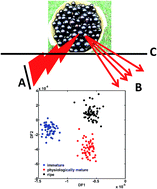Classification of jaboticaba fruits at three maturity stages using NIRS and LDA
Abstract
This study proposes a rapid and non-destructive method of jaboticaba [Myrciaria cauliflora (Mart.) O. Berg] fruit classification at three maturity stages based on the skin colour (immature – fruit completely green, physiologically mature – fruit turning from green to purple, and ripe – fruit completely purple) using Near-Infrared Reflectance Spectroscopy (NIRS) combined with principal component analysis-linear discriminant analysis (PCA-LDA), and variable selection techniques employing a successive projection algorithm (SPA-LDA) or genetic algorithm (GA-LDA). One hundred eighty jaboticaba fruit samples in three maturity stages were used and the multivariate classification accuracy results were tested based on sensitivity, specificity, positive (or precision) and negative predictive values, Youden index, and positive and negative likelihood ratios. In the immature stage the classification models PCA-LDA, GA-LDA and SPA-LDA achieved a sensitivity of 100% in the validation set. The results obtained in this study suggest that the proposed method is a promising alternative for assessing the jaboticaba fruit maturity, opening the possibility for automation in packing houses.


 Please wait while we load your content...
Please wait while we load your content...